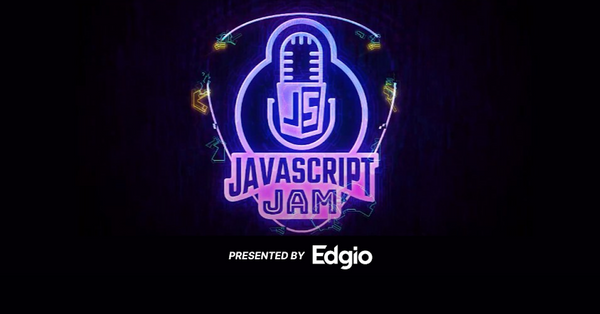JSJam Live, Wednesday at 12pm PT
This week we're reigniting our series of conference collaborations and talking with the good people at React Rally. The two day conference for developers of all backgrounds will be running from August 17th to the 18th. Tejas Kumar and Mark Erikson will be joining us to discuss their talks at the conference. Click here to set a reminder so you don't miss it!!
Last week, we discussed our Val Town episode and were joined by Dylan Pierce who told us a bit about Pipedream, a product that also offers a portable and easily executable glue code solution.
Story of the Week
Is the Jamstack Dead?
According to Jamstack pioneer Brian Rinaldi, we can pack it up and leave our static sites behind forever because the Jamstack is officially dead. At least that's what the headline might lead you to believe, but the actual message is a bit more nuanced. Brian's piece speaks more about the shifting priorities and interests of Netlify and the larger Jamstack community and less about whether it's still useful to build traditional static sites.
But it ignited a firestorm of responses that took various viewpoints on whether the term has died or not and what it means for how we will create modern, composable websites going forward. Early Netlify employee Swyx sought to drive the nail in the coffin with the following sentiment (and also provided a great blog post on the topic here):
I missed that JAMstack is officially dead now. First mention of it on the Netlify page is now in the footer. Look it was always a ridiculous term but... man. End of an era. It encouraged parsimony (good) but caught luddism (bad). More to write.
We'll look at many more viewpoints soon, but first I want to give my own take on this situation. Cards on the table here, since 2020 I've hosted a Jamstack branded podcast called FSJam and I built a lot of my early career on the Jamstack. I am as far from an impartial observer as you can get when it comes to this topic. Despite the clear conflict of interest, here's my take for what it's worth: Today I would still make the case for the continued life and vitality of the concept, if not the term.
Was the Jamstack a contrived marketing term from the beginning? Sure, probably. But to me the more important question continues to be, was the term describing a valuable architecture and style of website design? To that I would answer emphatically, yes! While some may be quick to declare the "death" of the Jamstack, it is crucial to remember that the term merely signifies an architectural concept, not a specific set of technologies.
The Jamstack has always sought to offer a way of building websites and apps that delivers improved performance, higher security, lower cost of scaling, and better developer experience. The architecture allowed developers to create faster, more secure sites that were easier to scale and maintain. Nothing has changed in that respect. Despite the controversy surrounding its name, the fundamental principles it encapsulates remain as relevant as ever.
Even if the term fades away, the essence of what the Jamstack represents, a powerful and efficient web development architecture, persists. In this light, it's not so much about the life or death of a term but the ongoing evolution and refinement of the concepts and methodologies it embodies in the ever-dynamic field of web development.
That's my take for what it's worth. However, hoping to get some more perspectives, I reached out to everyone I know who still has or has had a stake in this longstanding debate. Brian Douglas, the third employee at Netlify and host of Jamstack Radio, said the following:
I think these things are cyclical and leveraging things like Railway or Render make a lot of more sense now that server and edge compute are much cheaper. I think Netlify saw this coming and that is why they are moving away from JAM and now Jamstack or composable web.
I’d add that Jamstack gave us an opportunity to focus different parts of the stack and without it, we might not have strong use cases for Vite and esbuild, perhaps we’d still be paying Heroku $7 per dyno.
My friend and longtime Jamstack advocate Jim Fisk simply claimed that Jamstack should have just been called build-time rendering from the start. My boss at Edgio, Ishan Anand, who was locked in mortal combat with previous Vercel employee Jeff Escalante over the term said:
I said in one of our episodes Jamstack was going to be like HTML5. At the time it implies modern but will eventually fade away because its concepts will be borrowed into everything.
Jeff, seeing his moment for a victory lap after years of trying to kill the Jamstack terminology, wrote the following eulogy:
"Jamstack" has always been a marketing campaign for Netlify. While I am a big fan and advocate of Netlify as a tool and platform, I have watched with disappointment for years as they have tried to masquerade "jamstack" as a community-fueled architecture movement, while simultaneously exclusively owning the conference, website, and community forums.
And on top of that, they have been actively changing the definition of what it actually meant to match with Netlify's changing platform capabilities, and twisting it in subtle ways to ensure that their competitors were excluded. As a result of this, "Jamstack" has ended up as a deeply confusing buzzword that nobody can actually define, but has something to do with a way of building websites that you then go on to host with Netlify.
It was for years a great disservice to the development community, especially to newcomers who benefit from clear, coherent terminology and the ability to separate company marketing from genuine architecture concepts. This term will not be missed, to say the least. If anything comes from its demise, let it be in the form of lessons learned for developer tooling companies:
- Own your marketing and be genuine with it, make it clear what is marketing vs not.
- If you come up with a new concept that you'd like to name, ensure that the definition is extremely clear, and that it does not change after being initially defined.
- Draw clear lines between enterprise marketing and developer marketing.
Here's what Matt Biilmann, the man who first popularized the term itself said on Twitter where he takes a very celebratory view on the Jamstack's death, essentially saying that Jamstack is now the norm:
Jamstack won so much that it became less useful as a community term, since basically all modern web frameworks ended up being built around self standing front-ends talking to API's and services.
I don't think I can name a commercially successful CMS launched after I coined the Jamstack term. Same for ecommerce platforms. Shopify started to decouple their storefront from their backend services and expose them as an API. Different rendering model, but same architecture.
So many other examples. Wix started spinning off their backend features as headless API's for Jamstack sites (and are a great Netlify partner now). Sitecore's fastest growing product line is their API based cloud offering (and they're another great Netlify partner now).
If we really start seeing commercial traction around building monolithic fullstack apps for the web again, with rendering/business logic and data access all bundled together, we'll need to start evangelizing for a Jamstack approach again.
But meanwhile we might want to just focus on how we start simplifying the new stack that's emerged and grown more complex than it started out as. And on how we help the really large companies out there with big, complex web architectures adopt and modernize.
This was echoed by others like Abhi Aiyer who said, it's not dead, it's the norm. According to Paul Scanlon:
Jamstack was a movement. If you weren’t around before it, folks might not know how big of a deal it is/was. Things shifted so much that Jamstack is now just web development.
Current Netlify employee Matt Kane humorously put it like so:
What happened to flatscreen TVs? Everyone used to talk about them, and now nobody does! They were the hottest thing and now flatscreen TVs are dead.
I think you get the idea and I'll leave it here for now. But there was plenty more discussion on Twitter and Hacker News that I would encourage checking out if you find this topic interesting including a back and forth between Phil Hawksworth and Chris Ferdinandi about where solutions like Wordpress fit into this conversation.
Quick Links
- TkDodo - React Query and React Context
- Lab Zero - Upgrading an Ancient React Application
- Kedasha Kerr - How to build a GPT-3 App with Nextjs, React, GitHub Copilot
- Darius Cepulis - Everything I wish I knew before moving 50,000 lines of code to React Server Components
- Chris Jayden - Rate limiting requests with tRPC in SvelteKit
- Surma - Shopify’s platform is the Web platform
- Prashanth Chandrasekar - Announcing OverflowAI
Podcasts of the Week
- Web Rush - Angular 16 and ngConf
- DevtoolsFM - Linaer with Tuomas Artman
- PodRocket - Matt Pocock answers your TypeScript questions
- SyntaxFM - Rust for JavaScript Developers
One More Thing
Curious how we got here in this Jamstack debate? There's a long history of back and forth discussions about the meaning and purpose of the term. For a great overview, check out this recording of Ishan Anand's talk The Evolution of Jamstack recorded in May 2021:
We also had a great panel discussion back in the day with many of the people featured in this edition of the newsletter. Check it out here:
JavaScript Jam on the Web
Find us online at the following links:

